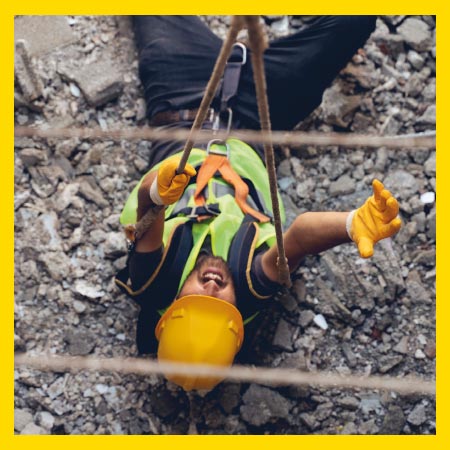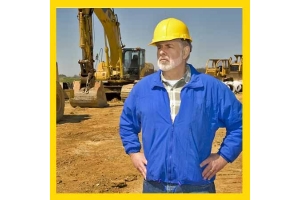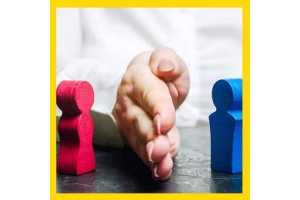Currency
March 28, 2022

Could you count them all? Could you even count the number of different things you have tripped on? Ok, so there are too many for any of us to count. But, if you really want an impossible task, try counting the number of things you didn’t trip on because you “just stepped over it”, whatever “it” was, like a cord or a hose or a step.
How many steps on stairs have you taken when you didn’t even so much as lose your balance? 100s, 1,000s or tens of thousands? Or is it hundreds of thousands? So, the reality is that we have all “negotiated” hundreds of thousands of what could be called a slip, trip or fall type of hazard, over the course of our lifetime; whether that’s a liquid spilled on the floor or a greasy handrail. And this number could easily be in the millions when you think about certain sports. And yet, those relatively few times when we actually fall, there is an overwhelming tendency to “blame” the hazard: the cord or the hose, or to blame whoever caused the spill or didn’t clean it up, instead of considering why – this time – did you actually fall?
Furthermore, why didn’t you carry it one step further and try to figure out what you actually need to do to prevent the next one. Which rarely happens even if there isn’t a “culprit hazard”. However, if you have had the “opportunity” to look at thousands and thousands of recordable injury reports from 100s and 100s of companies (because you are putting together their checklist of critical behaviors), you would probably start to laugh when it comes to the last column on the investigation report, which is, “action taken to prevent recurrence“especially when you look at “falls on stairways” and everybody’s got them (recordable on stairways). One of the most common things you will see is, “Re-instructed worker on policies and procedures for ascending and descending ladders and stairways”. “Re-indoctrinated worker” is also very popular…

Perhaps there were, “contributing factors”, like it was dark, or perhaps it was raining, or as was the case – I was debating on public radio in Australia – it was both, and the lighting in the yard was poor because one of the floodlights was burnt out. So, when the man slipped and fell getting off of a big bulldozer, what do you suppose the investigation focused on? Do you think they even bothered to consider his 28 years of experience, and the likelihood that he has gotten off a big piece of equipment every time – up until now – without hurting himself? In other words, as mentioned before, do you think they asked, “Why this time, when you have been able to do it so many other times: in the rain, in the dark, when it’s muddy and slippery. Why this time?” And here’s the next question, that is almost never asked, which is: “And what were you thinking about when it happened?”
Are slips, trips, and falls the outcome or the result? The cause is a problem with “balance, traction or grip”. So, while someone might very well think that hazard removal is the responsibility of the employer, very few people think it’s the company’s responsibility to keep their balance for them or maintain their grip or test it before they commit their weight. Furthermore, getting employees to focus on the cause (loss of balance), over which they have a lot of control, will be a start in terms of helping them to prevent making errors or mistakes with balance, traction or grip. However, that won’t be enough. Although it’s possible to lose your balance or grip without making another critical error, it’s rare. Almost all balance, traction or grip errors are predicated or set up by one or both of the first two critical errors, which are:
Eyes not on task, and mind not on task.
In other words, you didn’t see the cord you tripped on, or you didn’t think about the grass being slippery after the rain, or worse – the sharp corner on the road being slippery after it has just started raining. Eyes not on task and/or mind not on task usually set up the errors with balance, traction or grip. However, it’s not like we are making these mistakes all the time. Most people don’t even notice unless they actually fall or drop their phone and it breaks. Do you know how many times a day or a week you lose your balance now? If you were actually getting better or worse would you know it? And if you did know you were getting worse, would you know what to do about it? So how do you prevent eyes not on task and mind not on task (the first two critical errors)?
There are 4 states or human factors that cause 4 critical errors. This state to error risk pattern is involved in over 95% of all accidental acute injuries, whether they be at work, at home, in the community or on the road. (See Figure 1). If you’re questioning the 95%, just look at a reliable data base: what’s happened to you. Can you think of even one time in your life (not including sports) where you got hurt and you weren’t rushing, you weren’t frustrated or tired and you hadn’t become so complacent about the hazards and hazardous energy that you just weren’t thinking about it? If you’re like most people you can’t, or if you can it’s only one or two exceptions – for your whole life.
Now, can you think of a time (other than sports) when you got hurt when you had your eyes on task, you had your mind on task, you were aware of the line-of-fire and thinking about not losing your balance, traction or grip? Maybe – if a tree branch broke while you were climbing it, but again, that wouldn’t happen if you took the time to test it before committing your weight. But if your brother said, “Mom’s coming, you better get down before she sees you” then – because you’re rushing, you might not have tested that branch or made sure your foot didn’t slip. And those are just two of the problems rushing causes, other problems like not seeing the hazards because you’re moving quickly or not thinking about the risk because you’re thinking about why you’re rushing are potentially even bigger problems.
Rushing can also cause you to take a shortcut like not bothering with fall arrest when it’s a small job and it’s only 3 or 4 meters high. Although, in order to be willing to do that – despite whatever pressure you were under – you’d still have to be comfortable enough or complacent enough to be willing to do it in the first place. So, it’s usually a combination of states like rushing and complacency or rushing and frustration (road rage) that really affects our judgement.
If you look at the pattern again in Figure 1, you see that the states come before the errors. What this means is that we are in the state before we make the error. Once we make an error with balance, traction or grip the outcome or the result will likely be a slip, trip or fall, unless you regain your balance without falling, catch your phone before it hits the ground or recover from the skid without going off the road or into a big truck. In other words, just another close call or near-miss… But, if you didn’t regain your balance, catch your phone, etc. then it’s not a near miss, it’s an incident or injury. And how serious that will be will usually just be a matter of luck, combined with the overall amount of hazardous energy (a 1-meter fall is usually better than a 5-meter fall, and landing on your feet is usually better than landing on your head). So, once you lose your balance or make another critical error like moving into the line-of- fire, it’s too late.
We need something to trigger on before we make the error. And since there are only four states that predicate over 95% of these errors, that means we can use the active states: rushing, frustration and fatigue as the triggers. So as soon as you realise you’re rushing, that is: going faster than you normally go, instead of thinking about why you’re rushing or what can happen if you’re late, you need to be thinking about keeping your eyes on task, your mind on task (including the risk of what you’re doing, which might be driving over the speed limit so you’re not late for work or running down the stairs so you don’t miss the start of the meeting). And that is very counter-intuitive, so it takes a fair bit of training and practice to learn how to self-trigger quickly enough to prevent the error.
Learning how to self-trigger on the state is the first Critical Error Reduction Technique. And as mentioned, this technique works really well for rushing, frustration and fatigue because you can tell when you’re in a rush or when you’re frustrated, and you can certainly feel fatigue.
So back to the reliable data base: what percentage of the time that you’ve lost your balance, traction or grip were you in a rush? What percentage was caused or at least partially caused by frustration? And what percentage of your bad falls were fatigue? The reason I asked for bad falls on the last one is that fatigue slows down your reflexes. So, what might have been a close call or minimal injury can sometimes be a lot worse because you didn’t get all the benefit of your reflexes.
If you’re like most people, well over 60% of the falls you can remember involved rushing, frustration, or fatigue. You may even be as high as 75 or 80%, which means that if we learn how to self-trigger quickly enough to prevent making an error, we can reduce the loss of balance by 60 or 70% which will reduce the number of slips, trips and falls by the same amount.
Self-triggering is a two-step process. As soon as you realize you’re rushing or frustrated or tired, your first option is to reduce the state: slow down, calm down, or get some rest. Period. But that’s not always possible. So, if you can’t slow down, calm down, etc. then the next step is to make sure you keep your eyes and mind on the task. In other words, look for and/or think about what could cause you to lose your balance, traction or grip. Chances are, if you’re looking for things that could cause you to lose your balance, traction or grip and you’re thinking about it – you won’t have any problems. But in the very rare instances when you do still lose your balance – even when you were thinking about it – your reflex speed will be unimpaired. You will definitely still get the benefit – the full benefit – of your reflexes if you have you’re paying attention to the task at hand.
So, the first step (provided you’ve removed the slipping/tripping hazards and they’ve got good footwear) is to teach your employees how to self- trigger. That will be a big help for the rushing, frustration and fatigue. But what about complacency? Obviously, that state isn’t going to be so easy to self-trigger on. You can’t feel complacency within yourself. You can see it in other people – quite easily sometimes – but not with yourself.
How many steps on stairs have you taken when you didn’t even so much as lose your balance? 100s, 1,000s or tens of thousands? Or is it hundreds of thousands? So, the reality is that we have all “negotiated” hundreds of thousands of what could be called a slip, trip or fall type of hazard, over the course of our lifetime; whether that’s a liquid spilled on the floor or a greasy handrail. And this number could easily be in the millions when you think about certain sports. And yet, those relatively few times when we actually fall, there is an overwhelming tendency to “blame” the hazard: the cord or the hose, or to blame whoever caused the spill or didn’t clean it up, instead of considering why – this time – did you actually fall?
Furthermore, why didn’t you carry it one step further and try to figure out what you actually need to do to prevent the next one. Which rarely happens even if there isn’t a “culprit hazard”. However, if you have had the “opportunity” to look at thousands and thousands of recordable injury reports from 100s and 100s of companies (because you are putting together their checklist of critical behaviors), you would probably start to laugh when it comes to the last column on the investigation report, which is, “action taken to prevent recurrence“especially when you look at “falls on stairways” and everybody’s got them (recordable on stairways). One of the most common things you will see is, “Re-instructed worker on policies and procedures for ascending and descending ladders and stairways”. “Re-indoctrinated worker” is also very popular…

“those relatively few times when we actually fall, there is an overwhelming tendency to “blame” the hazard”
Rarely is there anything like a broken handrail, burnt out lightbulb or anything else that could be fixed. Although that would at least seem more substantial than “re-instructed worker”. And yet, it’s very rare for whoever was doing the investigation to ask about human factors that might help us to shine a bit of a light on the question of, “Why did you fall – this time?” it’s much more likely they will ask about the handrail or three-point contact, or if there was something like water or dirt which turned into slippery mud on the steps.Perhaps there were, “contributing factors”, like it was dark, or perhaps it was raining, or as was the case – I was debating on public radio in Australia – it was both, and the lighting in the yard was poor because one of the floodlights was burnt out. So, when the man slipped and fell getting off of a big bulldozer, what do you suppose the investigation focused on? Do you think they even bothered to consider his 28 years of experience, and the likelihood that he has gotten off a big piece of equipment every time – up until now – without hurting himself? In other words, as mentioned before, do you think they asked, “Why this time, when you have been able to do it so many other times: in the rain, in the dark, when it’s muddy and slippery. Why this time?” And here’s the next question, that is almost never asked, which is: “And what were you thinking about when it happened?”
Focus on cause vs. outcome
Are slips, trips, and falls the outcome or the result? The cause is a problem with “balance, traction or grip”. So, while someone might very well think that hazard removal is the responsibility of the employer, very few people think it’s the company’s responsibility to keep their balance for them or maintain their grip or test it before they commit their weight. Furthermore, getting employees to focus on the cause (loss of balance), over which they have a lot of control, will be a start in terms of helping them to prevent making errors or mistakes with balance, traction or grip. However, that won’t be enough. Although it’s possible to lose your balance or grip without making another critical error, it’s rare. Almost all balance, traction or grip errors are predicated or set up by one or both of the first two critical errors, which are:
Eyes not on task, and mind not on task.
In other words, you didn’t see the cord you tripped on, or you didn’t think about the grass being slippery after the rain, or worse – the sharp corner on the road being slippery after it has just started raining. Eyes not on task and/or mind not on task usually set up the errors with balance, traction or grip. However, it’s not like we are making these mistakes all the time. Most people don’t even notice unless they actually fall or drop their phone and it breaks. Do you know how many times a day or a week you lose your balance now? If you were actually getting better or worse would you know it? And if you did know you were getting worse, would you know what to do about it? So how do you prevent eyes not on task and mind not on task (the first two critical errors)?
Human factors cause critical errors
There are 4 states or human factors that cause 4 critical errors. This state to error risk pattern is involved in over 95% of all accidental acute injuries, whether they be at work, at home, in the community or on the road. (See Figure 1). If you’re questioning the 95%, just look at a reliable data base: what’s happened to you. Can you think of even one time in your life (not including sports) where you got hurt and you weren’t rushing, you weren’t frustrated or tired and you hadn’t become so complacent about the hazards and hazardous energy that you just weren’t thinking about it? If you’re like most people you can’t, or if you can it’s only one or two exceptions – for your whole life.
Now, can you think of a time (other than sports) when you got hurt when you had your eyes on task, you had your mind on task, you were aware of the line-of-fire and thinking about not losing your balance, traction or grip? Maybe – if a tree branch broke while you were climbing it, but again, that wouldn’t happen if you took the time to test it before committing your weight. But if your brother said, “Mom’s coming, you better get down before she sees you” then – because you’re rushing, you might not have tested that branch or made sure your foot didn’t slip. And those are just two of the problems rushing causes, other problems like not seeing the hazards because you’re moving quickly or not thinking about the risk because you’re thinking about why you’re rushing are potentially even bigger problems.
Rushing can also cause you to take a shortcut like not bothering with fall arrest when it’s a small job and it’s only 3 or 4 meters high. Although, in order to be willing to do that – despite whatever pressure you were under – you’d still have to be comfortable enough or complacent enough to be willing to do it in the first place. So, it’s usually a combination of states like rushing and complacency or rushing and frustration (road rage) that really affects our judgement.
Critical error reduction techniques
If you look at the pattern again in Figure 1, you see that the states come before the errors. What this means is that we are in the state before we make the error. Once we make an error with balance, traction or grip the outcome or the result will likely be a slip, trip or fall, unless you regain your balance without falling, catch your phone before it hits the ground or recover from the skid without going off the road or into a big truck. In other words, just another close call or near-miss… But, if you didn’t regain your balance, catch your phone, etc. then it’s not a near miss, it’s an incident or injury. And how serious that will be will usually just be a matter of luck, combined with the overall amount of hazardous energy (a 1-meter fall is usually better than a 5-meter fall, and landing on your feet is usually better than landing on your head). So, once you lose your balance or make another critical error like moving into the line-of- fire, it’s too late.
We need something to trigger on before we make the error. And since there are only four states that predicate over 95% of these errors, that means we can use the active states: rushing, frustration and fatigue as the triggers. So as soon as you realise you’re rushing, that is: going faster than you normally go, instead of thinking about why you’re rushing or what can happen if you’re late, you need to be thinking about keeping your eyes on task, your mind on task (including the risk of what you’re doing, which might be driving over the speed limit so you’re not late for work or running down the stairs so you don’t miss the start of the meeting). And that is very counter-intuitive, so it takes a fair bit of training and practice to learn how to self-trigger quickly enough to prevent the error.
Learning how to self-trigger on the state is the first Critical Error Reduction Technique. And as mentioned, this technique works really well for rushing, frustration and fatigue because you can tell when you’re in a rush or when you’re frustrated, and you can certainly feel fatigue.
So back to the reliable data base: what percentage of the time that you’ve lost your balance, traction or grip were you in a rush? What percentage was caused or at least partially caused by frustration? And what percentage of your bad falls were fatigue? The reason I asked for bad falls on the last one is that fatigue slows down your reflexes. So, what might have been a close call or minimal injury can sometimes be a lot worse because you didn’t get all the benefit of your reflexes.
If you’re like most people, well over 60% of the falls you can remember involved rushing, frustration, or fatigue. You may even be as high as 75 or 80%, which means that if we learn how to self-trigger quickly enough to prevent making an error, we can reduce the loss of balance by 60 or 70% which will reduce the number of slips, trips and falls by the same amount.
Self-triggering is a two-step process. As soon as you realize you’re rushing or frustrated or tired, your first option is to reduce the state: slow down, calm down, or get some rest. Period. But that’s not always possible. So, if you can’t slow down, calm down, etc. then the next step is to make sure you keep your eyes and mind on the task. In other words, look for and/or think about what could cause you to lose your balance, traction or grip. Chances are, if you’re looking for things that could cause you to lose your balance, traction or grip and you’re thinking about it – you won’t have any problems. But in the very rare instances when you do still lose your balance – even when you were thinking about it – your reflex speed will be unimpaired. You will definitely still get the benefit – the full benefit – of your reflexes if you have you’re paying attention to the task at hand.
So, the first step (provided you’ve removed the slipping/tripping hazards and they’ve got good footwear) is to teach your employees how to self- trigger. That will be a big help for the rushing, frustration and fatigue. But what about complacency? Obviously, that state isn’t going to be so easy to self-trigger on. You can’t feel complacency within yourself. You can see it in other people – quite easily sometimes – but not with yourself.









